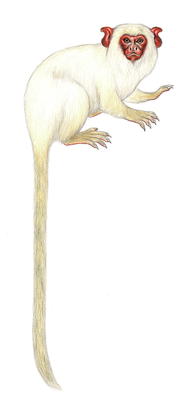White marmoset
| White marmoset | ||||||||||||
|---|---|---|---|---|---|---|---|---|---|---|---|---|

White marmoset ( Mico leucippe ) |
||||||||||||
| Systematics | ||||||||||||
|
||||||||||||
| Scientific name | ||||||||||||
| Mico leucippe | ||||||||||||
| ( Thomas , 1922) |
The white marmoset ( Mico leucippe , Syn .: Callithrix leucippe ) is a species of primate from the marmoset family . It used to be grouped into one species with the silver monkey .
features
White marmosets, like all marmosets, are relatively small primates. They reach a head body length of 21 to 24 centimeters, the tail is 27 to 37 centimeters long. Their fur is predominantly white in color, the limbs and long tail are yellowish - in contrast to the silver monkey, whose tail is black. The face is hairless, the large ears protrude from the fur. As with all marmosets, the fingers and toes (with the exception of the big toe) have claws instead of nails.
Distribution area and habitat
White marmosets inhabit a small area in the eastern Amazon basin in the Brazilian state of Pará . Their distribution area is between the Rio Tapajós and the Rio Cuparí . Their habitat are rainforests, whereby they are mainly in secondary forests and in more densely overgrown forest edges.
Way of life
Little is known about the way of life of these primates; it probably corresponds to that of the other marmosets . Accordingly, they are diurnal and sleep in the plant thicket or in tree hollows at night. They are tree dwellers and move on all fours or jumping.
Marmosets live in groups of 4 to 15 animals that are organized around a reproductive pair. Their diet consists of tree saps - for which they are adapted with their specialized teeth in the lower jaw that are able to gnaw holes in the tree bark. They also eat insects and other small animals as well as fruits. As with all marmosets, twins are usually born. The father and the other group members participate intensively in raising the young.
Danger
Since roads were built in the distribution area of the white marmosets in the 1970s, this region has been increasingly exposed to deforestation and the establishment of plantations. There are no protected areas in the distribution area. According to estimates by the IUCN , the total population has declined by 30% in the last 18 years, and the species is listed as "endangered" ( vulnerable ).
literature
- Thomas Geissmann : Comparative Primatology. Springer-Verlag, Berlin et al. 2003, ISBN 3-540-43645-6 .
- Don E. Wilson, DeeAnn M. Reeder (Eds.): Mammal Species of the World. A taxonomic and geographic Reference. Johns Hopkins University Press, Baltimore MD 2005, ISBN 0-8018-8221-4 .